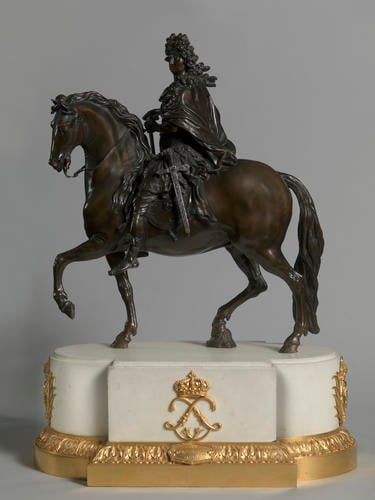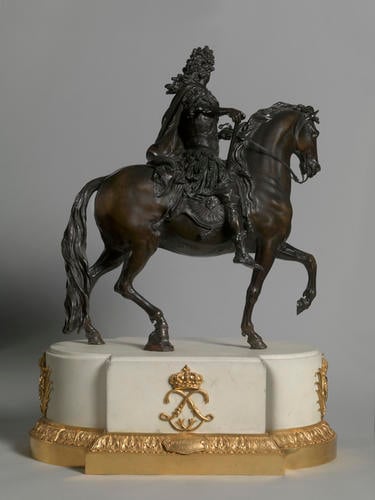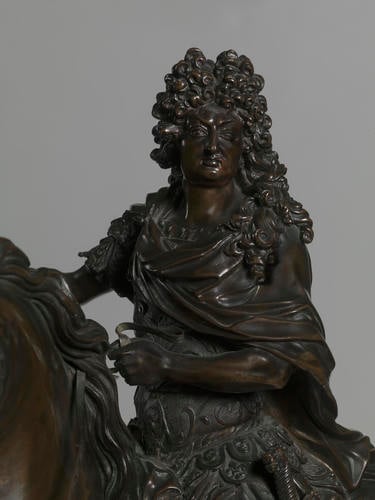-
1 of 253523 objects
King Louis XIV of France (1638-1715) c. 1694
Bronze, marble, gilt bronze | 61.0 x 45.7 x 31.5 cm (whole object) | RCIN 35464

Martin van den Bogaert Desjardins (1637-94)
King Louis XIV of France (1638-1715) c. 1694

Martin van den Bogaert Desjardins (1637-94)
King Louis XIV of France (1638-1715) c. 1694

Martin van den Bogaert Desjardins (1637-94)
King Louis XIV of France (1638-1715) c. 1694

Martin van den Bogaert Desjardins (1637-94)
King Louis XIV of France (1638-1715) c. 1694




-
A bronze statuette of Louis XIV of France sitting upright on a pacing horse and wearing a long wig and Roman armour, cast in one piece.
There are neither stirrups nor saddle. The king’s head is turned to his left. The long, vigorously curled and somewhat unruly wig falls down his back, and forward over his left shoulder. With his right hand he holds the end of a baton, the other end resting on his right knee. With his left hand he holds the reins in front of his body. His breastplate, decorated with scrollwork, is partly obscured by a cloak that falls over his shoulders on to the horse’s back. His kilt has three tiers of lappets decorated in turn with lions’ heads, fleurs-de-lis and piastre ornament; the underskirt has a raised band of fleurs-de-lis. The saddle-cloth has a radiating sun-mask in low relief, and tassels hang from the sides and corners. The king wears sandals tied with diagonally crossed tapes with a lion mask at the top. A straight sword in an embossed scabbard with a dog’s-head pommel hangs at the king’s left side. The horse’s head with a lively face and open mouth is turned slightly to the left, its mane and tail vigorously flowing backwards. The near foreleg is raised almost at right-angles, and the offside hind leg is slightly raised. The horse is attached by three of the feet to the rectangular white marble base with rounded ends, enriched with the arms and crown of France in gilt bronze. A piece of rock is cast on to the end of the off hind foot to give stability.
In 1686 the consuls of the city of Lyon decided to order an equestrian statue of Louis XIV to stand at the centre of a new square, the Place Louis-le-Grand (now Place Bellecour). Martin Desjardins was commissioned two years later by the duc de Villeroy, Marshal of France, in his capacity as governor of Lyon. It was the Inspector-general of Buildings, Jules-Hardouin Mansart (1646–1708) who laid down the essentials of the scheme, and Robert de Cotte (1656–1735) who designed the elaborate pedestal. The statue, 19 pieds high, was cast by Roger Schabol in Paris in 1694 in the Kellers’ foundry, but owing to the death of Desjardins himself in that year a delay ensued in bringing the finished bronze to Lyon. In fact it was not until 1713 that it was finally unveiled on the pedestal.
The statue was destroyed in 1792, but one fragment survived (the king’s foot, now in the Musée d’Histoire, Lyon). However, its appearance is known from an engraving by B. and J. Audran and by numerous bronze statuettes. Lorenz Seelig argues that the Royal Collection statuette differs from other representations of the statue in bronze in that is reflects the original intentions of Desjardins rather than recording the appearance of the statue after the fact. He argues that it is a cast of the artist’s model, produced in the sculptor’s own workshop, either by Martin or his nephew Jacques
Desjardins. He cites the relaxed pose of the rider, the modelling of the wig, the thorough and energetic handling of the drapery, and the ‘nervous yet graceful’ appearance of the horse as suggestive of an original work of art rather than a repetition. Moreover, the surface has received very little afterwork in comparison with other versions. In dating the bronze to before 1700, Seelig notes also that the king’s moustache, which is indicated here, was not seen after that date.
Text adapted from Sculpture in the Collection of His Majesty The King (2025)
Provenance
Purchased by George IV and first recorded on 1 May 1820 when sent to Benjamin Vulliamy (Jutsham, I, p. 348). The sword and the reins (the latter somewhat crude) were added in 1820 by Vulliamy, who also provided the gilt-bronze mounts. Vulliamy no doubt took his patterns from the other statuettes in the Collection.
Sent to Windsor Castle, 28 November 1828, where it was subsequently displayed in the Grand Corridor and Queen Victoria's Vestibule. -
Creator(s)
(nationality)(nationality)Acquirer(s)
-
Medium and techniques
Bronze, marble, gilt bronze
Measurements
61.0 x 45.7 x 31.5 cm (whole object)